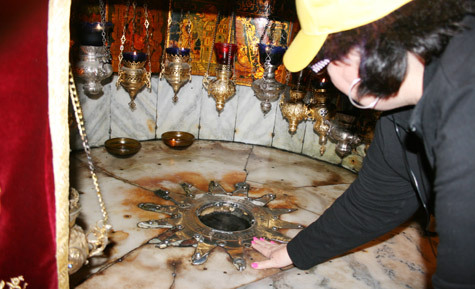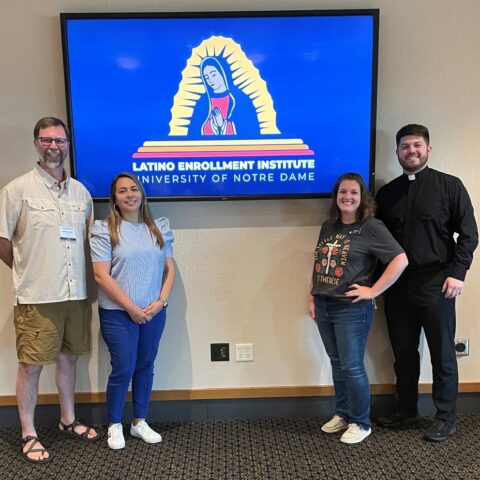While tracing the life of the Virgin Mary, one experiences a spiritual journey of personal discovery and reaffirmation of faith. By touring Israel, one is within the biblical landscape in which Mary lived, rejoiced and sorrowed.
 Nazareth is the town that was once a village where Jesus was raised. Strolling the streets and lanes of Nazareth, pilgrims can visit the Basilica of the Annunciation, which enshrines the grotto where the angel Gabriel appeared to the Virgin Mary (Luke 1:26-35) and a short distance away is the fountain at Mary’s Well where Mary drew water for the Holy Family.
Nazareth is the town that was once a village where Jesus was raised. Strolling the streets and lanes of Nazareth, pilgrims can visit the Basilica of the Annunciation, which enshrines the grotto where the angel Gabriel appeared to the Virgin Mary (Luke 1:26-35) and a short distance away is the fountain at Mary’s Well where Mary drew water for the Holy Family.
 According to Church tradition, the ancient town of Sepphoris (Zippori) was the birthplace of Mary, a tradition commemorated in the modern Franciscan Monastery of St. Anne and Joachim.
According to Church tradition, the ancient town of Sepphoris (Zippori) was the birthplace of Mary, a tradition commemorated in the modern Franciscan Monastery of St. Anne and Joachim.
 Cana was the site where Mary was present at the wedding feast, the scene of the first miracle of Jesus, where he turned the water into wine (John 2:1-11).
Cana was the site where Mary was present at the wedding feast, the scene of the first miracle of Jesus, where he turned the water into wine (John 2:1-11).
 Journeying on, pilgrims come to the Sea of Galilee and the ancient fishing village of Capernaum, where Jesus lived during much of his ministry. Mary accompanied her son to Capernaum (John 2:12). The Church of the House of St. Peter enshrines the remains of a one-room dwelling presumed to be the “House of Simon,” called Peter (Mark 1:29).
Journeying on, pilgrims come to the Sea of Galilee and the ancient fishing village of Capernaum, where Jesus lived during much of his ministry. Mary accompanied her son to Capernaum (John 2:12). The Church of the House of St. Peter enshrines the remains of a one-room dwelling presumed to be the “House of Simon,” called Peter (Mark 1:29).
 The final stop in the north of Israel is at the Monastery of Stella Maris dedicated to the Virgin Mary in her capacity as “Our Lady, Star of the Sea.” The nearby Elijah’s Cave has since Byzantine times been identified as a place where the Holy Family rested on its way back from Egypt.
The final stop in the north of Israel is at the Monastery of Stella Maris dedicated to the Virgin Mary in her capacity as “Our Lady, Star of the Sea.” The nearby Elijah’s Cave has since Byzantine times been identified as a place where the Holy Family rested on its way back from Egypt.
 Jerusalem, the Old City, is the next stop. In ancient times, as today, Jerusalem was the center of Jewish religious life. Mary, especially as an adult, may have visited the city at least once a year to pray at the Temple. Today’s pilgrims can visit the Western Wall, a remnant of the great retaining wall around the Temple Mount platform, which has long been a place of Jewish prayer and devotion.
Jerusalem, the Old City, is the next stop. In ancient times, as today, Jerusalem was the center of Jewish religious life. Mary, especially as an adult, may have visited the city at least once a year to pray at the Temple. Today’s pilgrims can visit the Western Wall, a remnant of the great retaining wall around the Temple Mount platform, which has long been a place of Jewish prayer and devotion.
While in the Old City, pilgrims can visit the 12th-century Church of St. Anne (Bethesda Pool), which enshrines the site that was according to Byzantine tradition, the birthplace of the Virgin Mary. The Via Dolorosa begins in the Muslin Quarter and ends at the Church of the Holy Sepulcher, in the Christian Quarter.
Of the 14 stations of the cross, four are directly or indirectly connected to Mary. The Church of the Holy Sepulcher contains several shrines dedicated to the Virgin Mary.
Outside the Old City walls, there is the Coenaculum (the “upper” room), a 14th-century hall in a small, two-story structure within a larger complex of buildings on the summit of Mount Zion commemorating the place where Jesus celebrated the Last Supper. It is also associated with an earlier tradition that this was the place (or at least the vicinity) where the disciples gathered with Mary and others of the community after the death of Jesus (Acts 1:14) and where they experienced the descent of the Holy Spirit at Pentecost (Acts 2:1-4).
The Tomb of the Virgin (Orthodox Church) is located at the foot of the Mount of Olives in the Valley of Jehoshaphat, an arm of the Kidron Valley, adjacent to the Garden of Gethsemane and the Church of All Nations.
 Finally, pilgrims can stop in Bethlehem and the Basilica of the Nativity. This is one of the earliest and most important of all Christian buildings, enshrining the cave believed to be the place where Jesus was born (Luke 2:7). The Milk Grotto, located in the crypt of a small Franciscan chapel, celebrates the tradition that the cave was used as a place of refuge by the Holy Family before their flight into Egypt.
Finally, pilgrims can stop in Bethlehem and the Basilica of the Nativity. This is one of the earliest and most important of all Christian buildings, enshrining the cave believed to be the place where Jesus was born (Luke 2:7). The Milk Grotto, located in the crypt of a small Franciscan chapel, celebrates the tradition that the cave was used as a place of refuge by the Holy Family before their flight into Egypt.
And so goes the spiritual life of the Mother Mary.
Carma Kelliher works for Compass Tours.
 Click here for the Catholic Travel 2011 section index.
Click here for the Catholic Travel 2011 section index.




